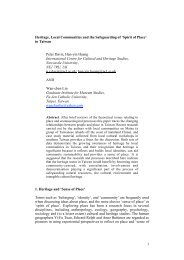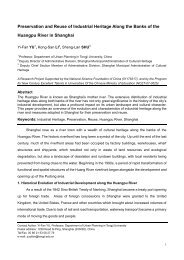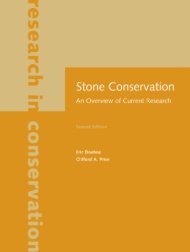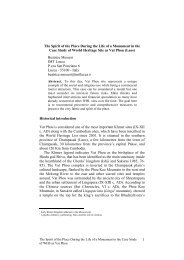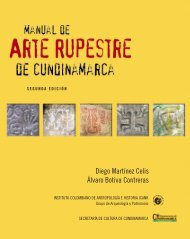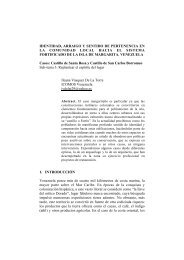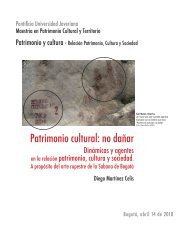the temple as a metaphor for the journey within - ICOMOS Open ...
the temple as a metaphor for the journey within - ICOMOS Open ...
the temple as a metaphor for the journey within - ICOMOS Open ...
Create successful ePaper yourself
Turn your PDF publications into a flip-book with our unique Google optimized e-Paper software.
THE TEMPLE AS A METAPHOR FOR THE JOURNEY WITHINAlan CrokerDesign 5 – Architects Pty Ltd5 Queen Street Chippendale NSW 2008 AustraliaEmail: alancroker@design5.com.auAbstract. This paper will explore <strong>the</strong> relationship between <strong>the</strong> tangibleand intangible <strong>as</strong> it is expressed in <strong>the</strong> South Indian Hindu <strong>temple</strong>, andidentify those <strong>as</strong>pects which embody and support this relationship. Thiswill <strong>as</strong>sist and in<strong>for</strong>m future conservation and management.The Hindu <strong>temple</strong> is a three dimensional diagram of <strong>the</strong> subtle levels ofexistence, which takes us from <strong>the</strong> mundane world to <strong>the</strong> divinityembodied in a particular image or icon in <strong>the</strong> sanctum. It is a <strong>metaphor</strong> <strong>for</strong><strong>the</strong> <strong>journey</strong> of <strong>the</strong> worshipper from this manifest world to <strong>the</strong> divinity<strong>within</strong>; a point of stillness beyond space and time, and beyond place.The place itself may be <strong>the</strong> physical locus <strong>for</strong> a particular <strong>as</strong>pect of <strong>the</strong>Absolute, but <strong>the</strong> realisation of that Absolute <strong>within</strong> oneself, is <strong>the</strong> ultimateaim of <strong>the</strong> <strong>temple</strong>. This is expressed in architecture, iconography, ritualand individual participation. Thus <strong>the</strong> <strong>temple</strong> in time and space (and<strong>the</strong>re<strong>for</strong>e place) h<strong>as</strong> its ultimate meaning beyond <strong>the</strong>se limitations.Sacred places in every tradition provide a focus towards <strong>the</strong> spiritualdimension, a place where this tangible world may be transcended and aglimpse of <strong>the</strong> intangible experienced. They act <strong>as</strong> gateways <strong>for</strong> <strong>the</strong>community between this tangible world and <strong>the</strong> intangible spiritual realmand provide a focus <strong>for</strong> those who seek to understand and experience thisrealm.Each tradition h<strong>as</strong> developed a rich language of iconography, ritual andarchitecture to guide and support <strong>the</strong> seeker on <strong>the</strong>ir path, but in recent times<strong>the</strong> meaning of <strong>the</strong>se languages have begun to be misunderstood or lost and<strong>the</strong>y are now incre<strong>as</strong>ingly discarded <strong>as</strong> meaning-less or valued only <strong>for</strong> <strong>the</strong>iraes<strong>the</strong>tic and historic qualities.While <strong>the</strong> Hindu tradition is still very strong and vital, <strong>the</strong>re are signsthat <strong>the</strong> <strong>for</strong>ces of disintegration are building. It is <strong>the</strong>re<strong>for</strong>e important tocounter <strong>the</strong>se <strong>for</strong>ces with explanation and discussion of some of <strong>the</strong>subtleties of <strong>the</strong> tradition so <strong>the</strong>y may be better understood, and thus valued.This tradition, with its many sects and philosophies, is b<strong>as</strong>ed on anancient Indian teaching and understanding that <strong>the</strong> Ultimate Reality (God <strong>as</strong>we generally refer to it in <strong>the</strong> west), is inseparable from all that is created –that all creation emanated from this reality and remains non-separate fromit.This teaching, known <strong>as</strong> Advaita Vedanta (Non-Duality), is regarded in<strong>the</strong> Hindu tradition <strong>as</strong> <strong>the</strong> ultimate goal of knowledge of <strong>the</strong> Divine.
2 ALAN CROKERIn this tradition, <strong>the</strong> ultimate God, known in Sanskrit <strong>as</strong> Brahman(literally that which is immense and from which everything else h<strong>as</strong> comeout), is beyond all name and <strong>for</strong>m, beyond all change and decay, beyond alllimitations of time and space. It is what I will refer to here <strong>as</strong> <strong>the</strong> Absolute.This Absolute is conscious, in fact it is consciousness itself and itsaturates all that exists. It is this consciousness which gives order to everyatom, every <strong>for</strong>m, and while in its unmanifest state it is perfectly still, it is<strong>the</strong> source of all energy and action. It is <strong>the</strong> still point at <strong>the</strong> centre, <strong>the</strong> hubof <strong>the</strong> moving wheel, where all movement ce<strong>as</strong>es and from where allmovement emanates.Verily, all this is <strong>the</strong> immortal Brahman! He is everywhere – above,below, in front, at <strong>the</strong> back, upon <strong>the</strong> right, upon <strong>the</strong> left! All thisworld is indeed Brahman! (Mundaka Upanishad; verse 2.2.11)The same Deity (God) who is one only, remains hidden in all beings,is all-perv<strong>as</strong>ive and <strong>the</strong> indwelling Self of all beings. He presidesover all actions, lives in all beings, (He is) <strong>the</strong> witness, <strong>the</strong> PureConsciousness free from <strong>the</strong> three Gun<strong>as</strong> (qualities) of Nature.(Svet<strong>as</strong>vatara Upanishad; verse 6.11)We can observe that <strong>the</strong> world we experience and interact with is subject tochange and decay – it is impermanent. We can also observe that permeatingour own experience of it, observing all this change, is our own constantawareness of our selves. Even when we think we have ‘lost’ this awarenessor consciousness <strong>as</strong> in a deep sleep or coma, it is not lost or destroyed, it h<strong>as</strong>merely become absolutely still and withdrawn, re-awakened when we‘regain’ consciousness. It is only by <strong>the</strong> light or activity of thatconsciousness that we know or experience anything. It is said in thistradition, that <strong>the</strong> most refined, most pure <strong>for</strong>m of this consciousness orSelf, resides in a small cave or chamber deep inside <strong>the</strong> heart. This isknown <strong>as</strong> <strong>the</strong> Atman or soul.V<strong>as</strong>t, self-effulgent, divine, beyond all imagination, shines <strong>the</strong> truthof Brahman. It is subtler than <strong>the</strong> subtlest, far<strong>the</strong>r than <strong>the</strong> far<strong>the</strong>st.It is here <strong>within</strong> this body, and <strong>the</strong> sages realise it verily in this life<strong>as</strong> seated in <strong>the</strong> heart. (Mundaka Upanishad; verse 3.1.7)The Upanishads tell us that this individual consciousness or Atman, is <strong>the</strong>same <strong>as</strong> that of <strong>the</strong> Absolute. Not only is it <strong>the</strong> same, it is not separate fromit. This is <strong>the</strong> ultimate teaching of Advaita Vedanta (non-duality) and isepitomised in <strong>the</strong> great words quoted below, ‘Tattwam<strong>as</strong>i’, ‘Thou art That’,and is repeated in a number of <strong>the</strong> upanishads.That which is <strong>the</strong> subtlest of all is <strong>the</strong> Self of all this. It is <strong>the</strong> Truth.It is <strong>the</strong> Self. Thou art That, O Svetaketu. (Chandogya Upanishad;verse 6.8.7)
THE TEMPLE AS A METAPHOR FOR THE JOURNEY WITHIN 3To find this <strong>for</strong> ourselves, <strong>the</strong> upanishads tell us we must stop lookingoutwards, and begin <strong>the</strong> <strong>journey</strong> inwards, to that still point of pureawareness in <strong>the</strong> core of <strong>the</strong> heart. A well known path to achieve this is viameditation.According to <strong>the</strong> Indian tradition, our bodies are made up of five sheaths– known in Sanskrit <strong>as</strong> kosh<strong>as</strong>. These kosh<strong>as</strong> can be likened to <strong>the</strong> layeredskins in an onion, but in this c<strong>as</strong>e <strong>the</strong>y progress from <strong>the</strong> outer tangible layerto <strong>the</strong> innermost intangible core. The outer physical layer - annamaya koshais <strong>the</strong> food sheath. Our physical bodies are sustained by food. Then comespranamaya kosha, <strong>the</strong> vital breath; next is manomaya kosha, <strong>the</strong> thinkingmind; <strong>the</strong>n vignanamaya kosha, knowledge/ego/I-ness; and finallyanandamaya kosha, <strong>the</strong> bliss sheath, that inner core of sublime happinessexperienced when we know who we really are. At <strong>the</strong> centre of this blisssheath is <strong>the</strong> tiny cave or chamber in <strong>the</strong> core of our being, <strong>the</strong> heart,holding <strong>the</strong> Atman. This is our still point of consciousness.This same structure can be found in <strong>the</strong> Hindu <strong>temple</strong>. Refer to Kosh<strong>as</strong>diagram in figure 1 below. While every <strong>temple</strong> is different and houses adifferent <strong>for</strong>m or <strong>as</strong>pect of <strong>the</strong> Divine, this principle of <strong>the</strong> <strong>journey</strong> from <strong>the</strong>outside world to <strong>the</strong> central chamber housing <strong>the</strong> Divine, <strong>the</strong> sanctum, iscommon to all <strong>temple</strong>s. This is a fundamental principle and in this paper Iwill refer to Shiva <strong>temple</strong>s of South India to demonstrate it.Figure 1. Va<strong>as</strong>tu Purusha diagram (left) and Kosh<strong>as</strong> diagram (right)The Hindu <strong>temple</strong> is set out according to <strong>the</strong> ancient rules and teachings of<strong>the</strong> Va<strong>as</strong>tu Sh<strong>as</strong>tra with <strong>the</strong> Va<strong>as</strong>tu Purusha Mandala <strong>as</strong> its controllinglayout, a centred square diagram of ei<strong>the</strong>r 8 x 8 or 9 x 9 squares. It is saidthat in ancient times, a demon called Va<strong>as</strong>tu w<strong>as</strong> creating chaos in <strong>the</strong> wholeuniverse and <strong>as</strong> a result, w<strong>as</strong> <strong>for</strong>ced down to earth by Lord Indra. Landingface down, <strong>the</strong> Lord instructed that he be held down by <strong>the</strong> Dev<strong>as</strong> of each of<strong>the</strong> directions to create order. Refer to figure 1 showing an 8 x 8 diagram
4 ALAN CROKERabove. To explain this Va<strong>as</strong>tu Purusha Mandala is beyond <strong>the</strong> scope of thispaper and readers are referred to <strong>the</strong> Reference list, particularly those worksby V. Ganapati Sthapati and S. Ananth. Suffice it to say that inimplementing this Va<strong>as</strong>tu Purusha diagram in accordance with <strong>the</strong> tradition,order replaces chaos, space is made sacred, all directions of space areprotected, and all <strong>for</strong>ces and energies of <strong>the</strong> site are balanced and ordered.At <strong>the</strong> centre of this diagram is <strong>the</strong> point where all energies are focussed andhave <strong>the</strong>ir source, where <strong>the</strong> deity in <strong>the</strong> sanctum is located. The sanctumrepresents <strong>the</strong> cave in <strong>the</strong> heart and <strong>the</strong> deity at its centre, an <strong>as</strong>pect of <strong>the</strong>Divine, <strong>the</strong> Absolute.There are three principal deities in <strong>the</strong> Hindu tradition; Brahma <strong>the</strong>creator, Vishnu <strong>the</strong> preserver/sustainer, and Shiva <strong>the</strong> destroyer, all ofwhom are represented <strong>as</strong> m<strong>as</strong>culine. These represent <strong>the</strong> three principal<strong>as</strong>pects of <strong>the</strong> Absolute and contain <strong>within</strong> <strong>the</strong>m <strong>the</strong> ability to act. Thisability or energy is considered <strong>as</strong> feminine. Thus each h<strong>as</strong> a consort and<strong>the</strong>se are usually represented <strong>as</strong> separate images. Brahma h<strong>as</strong> Sar<strong>as</strong>wati –goddess of speech music and learning; Vishnu h<strong>as</strong> Lakshmi – goddess ofbeauty, abundance and wealth; and Shiva h<strong>as</strong> Parvati – a goddessrepresented in many diverse <strong>for</strong>ms from Uma – <strong>the</strong> nurturing mo<strong>the</strong>r, toDurga – <strong>the</strong> destroyer of demons and evil, to Kali – destroyer of ignorance.Each of <strong>the</strong>se Lords and Goddesses take on specific <strong>for</strong>ms according to<strong>the</strong>ir location and its <strong>as</strong>sociated energies, hence <strong>the</strong>ir exists <strong>within</strong> <strong>the</strong>tradition multitudinous <strong>as</strong>pects of <strong>the</strong> Divine which can be worshippedaccording to ones own personality and understanding. At its traditionalcore, each follower would acknowledge that every <strong>for</strong>m of <strong>the</strong> Divine is butone of many <strong>as</strong>pects or faces of <strong>the</strong> same Absolute, beyond duality.The truth (Ultimate Reality) is One, Sages call it by different names.(Rig Veda; 1, 164.46)While many individuals may follow established family allegiances toparticular deities, it is commonly accepted that each chooses or finds that<strong>for</strong>m of <strong>the</strong> Divine which most resonates with <strong>the</strong>m personally. Thus whena worshipper visits a <strong>temple</strong> housing <strong>the</strong>ir chosen deity, <strong>the</strong>y are comingface to face with that <strong>as</strong>pect of <strong>the</strong> Absolute which most closely resonateswith <strong>the</strong>ir own inner being, <strong>the</strong>ir own Atman.There are many layers of meaning embodied in <strong>the</strong> Hindu <strong>temple</strong> but inthis paper I will only discuss those which relate to <strong>the</strong> principles of Advaita.If we look at <strong>the</strong> arrangement of <strong>the</strong> <strong>temple</strong>, it is set out in a series ofconcentric courtyards (prakar<strong>as</strong>), with a gateway at <strong>the</strong> entrance to each.These gateways are generally in line with <strong>the</strong> cardinal directions, <strong>the</strong> mainones marked by large towers (gopurams). The sanctum is in <strong>the</strong> innermostcourtyard like <strong>the</strong> seed in <strong>the</strong> centre of a fruit. This arrangement closelycorrelates to <strong>the</strong> concept of <strong>the</strong> five kosh<strong>as</strong> and is clearly evident intraditional South Indian <strong>temple</strong>s. In <strong>the</strong> large Shiva <strong>temple</strong>s of this region,
6 ALAN CROKERgateway, we leave it behind and proceed towards <strong>the</strong> centre, each courtyardbringing us closer to <strong>the</strong> most subtle, most sacred part of <strong>the</strong> <strong>temple</strong>. Weare following a clockwise path from <strong>the</strong> gross world to <strong>the</strong> subtle, and whilewe may be doing this on a spatial, physical level, we are in fact mirroring aninternal process, a <strong>journey</strong>, a pilgrimage, to that cave in <strong>the</strong> centre of ourown heart wherein <strong>the</strong> Divine dwells <strong>as</strong> our Atman.The <strong>temple</strong> sanctum is square in plan, almost cubic in volume, and istraditionally dark. Iconographically in this tradition, <strong>the</strong> still point at <strong>the</strong>centre of creation is represented by a square or a cube, <strong>the</strong> most stable andinert of all shapes or solids, while <strong>the</strong> circle represents this manifest,changing world. The central axis of this sanctum is <strong>the</strong> still thread ofconsciousness, and is referred to <strong>as</strong> <strong>the</strong> Brahma Sutra (thread/axis ofBrahma). It corresponds with this same axis in <strong>the</strong> human <strong>for</strong>m, effectively<strong>the</strong> centre of balance and equilibrium. Refer to figure 4 below.Figure 4. Human <strong>for</strong>m and Temple <strong>for</strong>m, <strong>the</strong> latter being a diagram of <strong>the</strong><strong>for</strong>mer.(adapted by <strong>the</strong> author from diagrams in V Ganapati Sthapati, 1997, page108)If we consider a square of paper or card and spin it on its central axis, itwill, with enough speed, appear circular, but really it is just a square. In thisanalogy <strong>the</strong> square and <strong>the</strong> circle appear to be different, but are really only a
THE TEMPLE AS A METAPHOR FOR THE JOURNEY WITHIN 7square, one absolutely still with no action/energy, and <strong>the</strong> o<strong>the</strong>r withaction/energy. In some <strong>temple</strong>s, particularly in Kerala, <strong>the</strong> outside of <strong>the</strong>sanctum may be circular in plan but <strong>the</strong> space inside it is square, rein<strong>for</strong>cing<strong>the</strong> teaching that what we see in this world is subject to change and decayand that which is unseen <strong>within</strong> it <strong>as</strong> its source, is stillness, beyond changeand decay. In South India, <strong>the</strong> worshipper cannot enter <strong>the</strong> sanctum, butwhen <strong>the</strong> priest per<strong>for</strong>ms <strong>the</strong> ritual known <strong>as</strong> ‘aarati’, waving a sacredcamphor lamp in front of <strong>the</strong> image, both <strong>the</strong> space and <strong>the</strong> image <strong>within</strong> areglimpsed – <strong>the</strong> sacred stillness of <strong>the</strong> Absolute is revealed. But it does notend <strong>the</strong>re.The pre-eminant image in a Shiva <strong>temple</strong> is <strong>the</strong> Shiva lingam. This is avertical shaft of stone (m<strong>as</strong>culine), generally circular in plan, in <strong>the</strong> centre ofa raised plat<strong>for</strong>m or yoni (feminine). This image is often referred to <strong>as</strong> ‘<strong>the</strong><strong>for</strong>m of <strong>the</strong> <strong>for</strong>mless’ and is an extraordinarily clear and powerful image of<strong>the</strong> fundamental <strong>for</strong>ces and qualities in <strong>the</strong> cosmos. It ultimately embodiesand resolves all opposites, evolution and involution, movement andstillness, male and female, <strong>for</strong>m and <strong>for</strong>mless. This is an abstract image of<strong>the</strong> Absolute which transcends all <strong>for</strong>ms and qualities.‘Shiva’ means ‘auspiciousness - <strong>the</strong> auspicious one’, and ‘lingam’means ‘sign’. Just <strong>as</strong> smoke is a sign or ‘lingam’ of its true source fire, so<strong>the</strong> Shiva Lingam is a sign or marker of its source, <strong>the</strong> auspicious one –Shiva.This is what we see, but what we do not see is <strong>the</strong> section of this shaftwhich is <strong>within</strong> <strong>the</strong> yoni, and still ano<strong>the</strong>r section below it buried <strong>within</strong> <strong>the</strong>floor of <strong>the</strong> sanctum. Refer figure 5 below.
8 ALAN CROKERFigure 5. The Shiva Lingam(adapted by <strong>the</strong> author from diagrams in V. Ganapati Sthapati, 2002, page36)The square planned section hidden in <strong>the</strong> floor represents Brahma, <strong>the</strong>creator, that which is unmanifest, <strong>the</strong> unseen motionless consciousness. Theoctagonal middle section concealed by <strong>the</strong> yoni is Vishnu, <strong>the</strong> preserver,that which is moving with order and control, maintaining and sustainingcreation. In this octagonal section, <strong>the</strong> central axis of consciousness isvibrating to produce <strong>the</strong> manifest world; just <strong>as</strong> <strong>the</strong> filament in a light globevibrates when energised to produce light and heat. The visible circularplanned section, rotating at high speed around this eternally still central axisis Rudra, <strong>the</strong> ancient name <strong>for</strong> Shiva <strong>the</strong> destroyer. This is <strong>the</strong> fullflowering of existence but it is also potentially self-destructive. What wesee in this upper section is really <strong>the</strong> energy or power of Shiva, that of hisconsort Shakti. To quote <strong>the</strong> Great South Indian Sage, Adi Shankara:When Shiva is enjoined with Shakti, he is empowered to create.If <strong>the</strong> lord is not thus, he is indeed unable to even move.(Saundarya Lahari: verse 1)This still point cannot be seen with <strong>the</strong> eyes but it can be understood tosome degree by <strong>the</strong> intellect <strong>as</strong> <strong>the</strong> single vertical axis of consciousness, <strong>the</strong>Axis Mundi, <strong>the</strong> still point at <strong>the</strong> centre of this movement, connecting allthree parts like beads on a thread. This consciousness is at <strong>the</strong> heart ofeverything, every atom, <strong>as</strong> its source and continuing support.So once again, <strong>the</strong> iconography rein<strong>for</strong>ces <strong>the</strong> fact that this Absolutecannot be seen or perceived by <strong>the</strong> senses, but only by deep contemplationon that <strong>for</strong>m of <strong>the</strong> Divine in <strong>the</strong> centre of <strong>the</strong> cave of <strong>the</strong> heart.O<strong>the</strong>r images of Lord Shiva, such <strong>as</strong> <strong>the</strong> well known image of LordNataraja, <strong>the</strong> dancing <strong>for</strong>m of Shiva <strong>within</strong> <strong>the</strong> circle of flame, reveals <strong>the</strong>sesame principles in a different but no less profound manner. The dancecreates, sustains and <strong>the</strong>n destroys <strong>the</strong> universe, but it also represents <strong>the</strong>process of conquering and destroying our own ignorance <strong>as</strong> to who wereally are. Only when we understand and achieve this do we receive <strong>the</strong>Divine Grace of liberation offered by His lifted foot.At ano<strong>the</strong>r level of meaning, this manifest world is nothing o<strong>the</strong>r than adance per<strong>for</strong>med by <strong>the</strong> Lord Himself (or more correctly His Shakti) andh<strong>as</strong> no real existence of its own, it is only an appearance caused by <strong>the</strong>vibration of <strong>the</strong> central core axis of <strong>the</strong> universe. When <strong>the</strong> dance or <strong>the</strong>vibration ce<strong>as</strong>es, <strong>the</strong> world is no more.The doorway in <strong>the</strong> <strong>temple</strong> symbolises <strong>the</strong> same principle. Each is reallya representation of a single undifferentiated column shaft, sliced or splitdown <strong>the</strong> centre and <strong>the</strong>n when <strong>the</strong> two halves part we can see what isrevealed <strong>within</strong>. That which is non-dual, divides itself to produce duality
THE TEMPLE AS A METAPHOR FOR THE JOURNEY WITHIN 9and <strong>within</strong> <strong>the</strong> framework provided by this duality, a face or <strong>as</strong>pect of <strong>the</strong>Absolute is revealed. Refer to figure 6 below. In each of <strong>the</strong> niches around<strong>the</strong> outside of <strong>the</strong> sanctum or on <strong>the</strong> outside of <strong>the</strong> gopuram, images of <strong>the</strong>Divine are revealed to us <strong>within</strong> <strong>the</strong> frame of one of <strong>the</strong>se doorways. Theoutside face of <strong>the</strong>se structures is <strong>the</strong> manifest world, faces or projections of<strong>the</strong> unmanifest <strong>within</strong> <strong>the</strong> sanctum.Figure 6. Lord Shiva <strong>as</strong> <strong>the</strong> naked beggar, e<strong>as</strong>tern gopuram,TiruvannamalaiIn visiting any of <strong>the</strong>se <strong>temple</strong>s, <strong>the</strong> worshipper’s <strong>journey</strong> is structured andgiven meaning by its architectural and iconographic arrangement. Thevarious rituals, chants and offerings per<strong>for</strong>med at particular points along this<strong>journey</strong>, rein<strong>for</strong>ce this process and <strong>the</strong> worshipper can understand <strong>the</strong>meaning of <strong>the</strong>se according to <strong>the</strong>ir own knowledge and devotion.At festival times, particularly when <strong>the</strong> deity comes out of <strong>the</strong> <strong>temple</strong>and is taken on procession, <strong>the</strong> sense of <strong>the</strong> Divine participating in <strong>the</strong>worshipper’s worldly life becomes more tangible. This helps <strong>the</strong>worshipper to integrate what is understood in <strong>the</strong> sanctum with <strong>the</strong>ireveryday life and to infuse it with spiritual principles. In this manner <strong>the</strong>manifest world, <strong>the</strong> world of transaction and interaction, can, with devotionand understanding, become saturated with this Divine presence.
10 ALAN CROKERFigure 7. Lord Arunachaleswara and His consort on procession in <strong>the</strong>streets of TiruvannamalaiOnce this principle of <strong>the</strong> transcendent Divine, <strong>the</strong> Absolute, saturating<strong>the</strong> universe is understood, integrated and experienced, <strong>the</strong> <strong>journey</strong> iscomplete and <strong>the</strong> <strong>temple</strong> itself and its iconography are transcended. Theexperience of <strong>the</strong> Absolute, beyond all space and time, <strong>for</strong>m and place isachieved. None<strong>the</strong>less <strong>the</strong> <strong>temple</strong> remains <strong>as</strong> <strong>the</strong> point of entry to this greatsecret, <strong>the</strong> symbol on <strong>the</strong> path, <strong>the</strong> doorway in <strong>the</strong> apparently impenetrablewall which surrounds this cave in <strong>the</strong> centre of <strong>the</strong> heart.AcknowledgementsAll photographs by <strong>the</strong> authorREFERENCESNote: <strong>the</strong>re are many translations of <strong>the</strong> Upanishads and o<strong>the</strong>r Vedic texts.I have selected those that are generally considered among <strong>the</strong> more accurate.Ananth, S<strong>as</strong>hikala. 1998 The Penguin Guide to Va<strong>as</strong>tu – The Cl<strong>as</strong>sicalIndian Science of Architecture and Design New Delhi: PenguinBooksGambhirananda, Swami (translator) 1986 Svet<strong>as</strong>vatara Upanishad – with<strong>the</strong> Commentary of Sankaracharya Calcutta: Advaita AshramaGanapati Sthapati, V. 1997 Science & Technology of Va<strong>as</strong>tu Sh<strong>as</strong>traMadr<strong>as</strong>: Va<strong>as</strong>tu Vedic Research FoundationGanapati Sthapati, V. 2001 Building Architecture of Sthapatya VedaChennai: Dakshinaa Publishing House
THE TEMPLE AS A METAPHOR FOR THE JOURNEY WITHIN 11Ganapati Sthapati, V. 2002 Indian Sculpture & Iconography Pondicherry:Sri Aurobindo SocietyGriffith, Ralph T. H. (translator) 1973 The Hymns of <strong>the</strong> Rgveda Delhi:Motilal Banarsid<strong>as</strong>sLokeswarananda, Swami (translator) 1998 Chandogya UpanishadCalcutta: Ramakrishna Mission Institute of CultureMichell, George 1989 The Penguin Guide to <strong>the</strong> Monuments of India –Volume 1: Buddhist, Jain, Hindu London: Penguin BooksSarvananda, Swami. (translator) undated Mundaka Upanishad Madr<strong>as</strong>: SriRamakrishna MathSnodgr<strong>as</strong>s, Adrian 1990 Architecture, Time and Eternity – Studies in <strong>the</strong>Stellar and Temporal Symbolism of Traditional buildings 2 Vols.New Delhi: AdityaSubrahmanya S<strong>as</strong>tri, Pandit S, and Sriniv<strong>as</strong>ya Ayyangar, T R. (translation)1965 Saundarya-Lahari, of Sri Sankara Madr<strong>as</strong>: TheosophicalPublishing House



